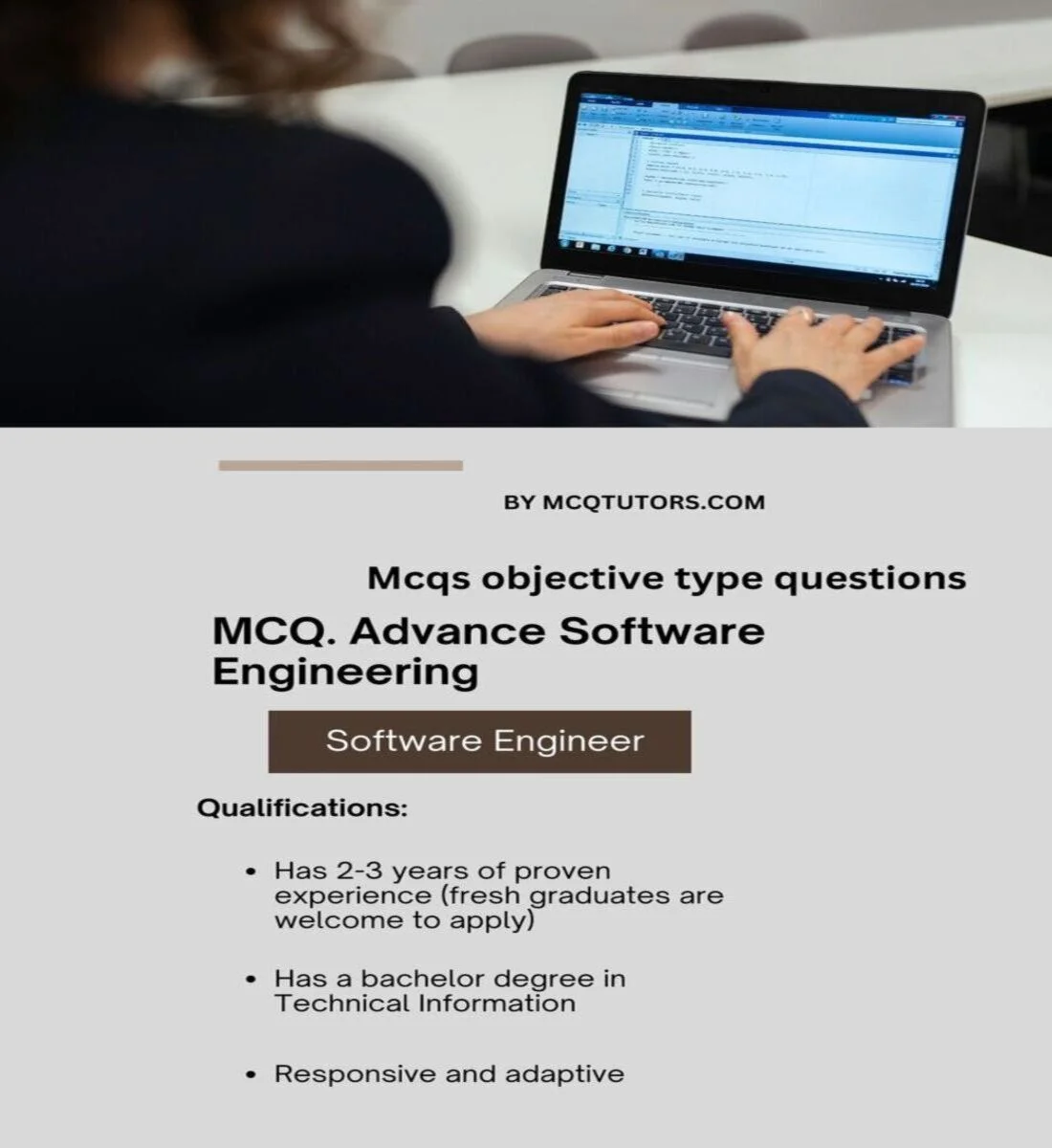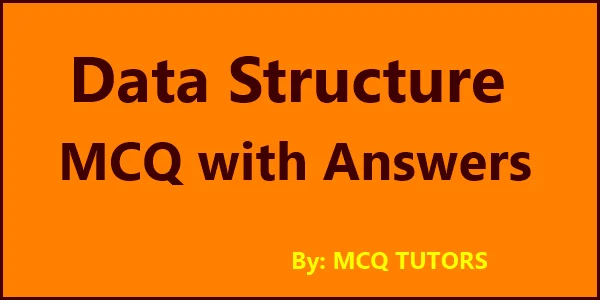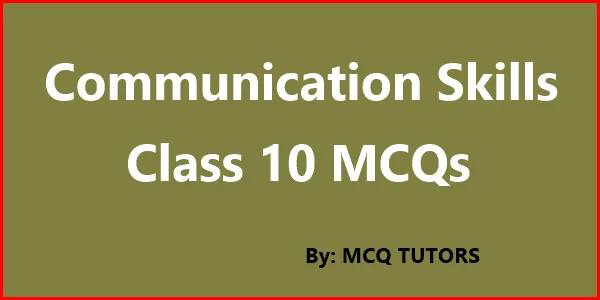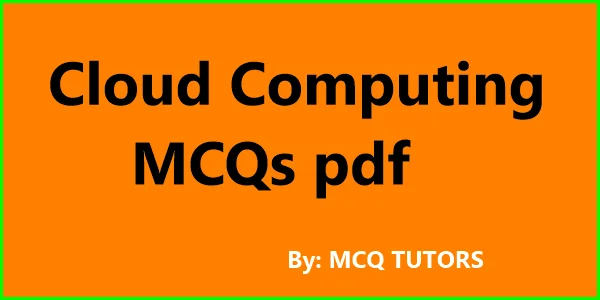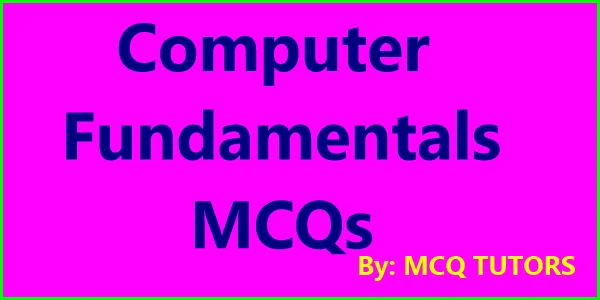Are you looking to test your knowledge of Advance Software Engineering? If so, then this article is for you. Here we will provide a number of Multiple Choice Questions (MCQs) on the subject of Advance Software Engineering.
This article will be an excellent resource for students or professionals who want to learn more about this topic and test their skills at the same time.
With the help of these MCQs, readers can quickly assess their knowledge level and gain a better understanding of the subject.
45 MCQ on Advance Software Engineering
1. ___ is a set of programs that are built by software engineers
a) Software
b) Hardware
c) Program
d) Application
Ans: A
2. Which of the following is not the characteristic of software?
a) Software is developed or engineered; it is not manufactured in the classical sense
b) Software does not “wear-out”
c) Software is manufactures, not developed
d) Although the industry is moving toward compound based assembly most s/w continues to be custom built.
Ans: C
3. ___ collection of programs written to service other program
a) System Software
b) Real Time Software
c) Business Software
d) Embedded Software
Ans: A
4. This type of software makes use of non numerical algorithm to solve complex problems that are not forward analysis.
a) Personal Computer software
b) Web Based Software
c) Business Software
d) AI software
Ans: D
5. ___ is an engineering discipline which is concerned with a ll aspects of software production.
a) Software Developing
b) Software Engineering
c) Software Manufacturing
d) None of the Above
Ans: B
6. According to Boehm the definition of software engineering
a) It is the application of science & mathematics by which the capabilities of computer equipment are made useful to humans via computer program, procedures & associated documentation
b) S/w engineering is nothing but the establishment & use of sound engineering principles in order t o obtain economical s/w that is reliable & works efficiently on real machines
c) It is the systematic approach to development, operations, maintenance & retirement of Software
d) None of the above
Ans: A
7. This model suggests a systematic sequential approach to software development that begins at the system level and progresses through analysis, design, coding, testing, and support.
a) Waterfall Model
b) Spiral Model
c) RAD Model
d) Iterative Model
Ans: C
8. Which of the following is not the limitation of the linear sequential model?
a) This model assumes the requirement of a system which can be frozen before the design begins.
b) This model stipulates that the requirements be completely specified before the rest of the development can proceed
c) This model is not used when technical risks are high
d) It is document driven approach that requires formal documents at the end of each phase.
Ans: C
9. Which of the following is not the phase for RAD Models?
a) Business Modeling
b) Data Modeling
c) Process Modeling
d) Designing
Ans: D
10. Using this model software is developed in a series of incremental releases.
a) RAD
b) Spiral
c) Parallel or Concurrent Development Model
d) Component based Model
Ans: B
11. ___ is inserting playful bugs into programs, creating viruses, writing quick and dirty code just to meet a schedule or a market window, shipping defective software and even shipping software that works but does not meet the agreed upon specification is unethical
a) Hacking
b) Cracking
c) Breaking
d) None of the above
12. ___ is a function of the number of failures experienced by a particular user of that software.
a) Software reusability
b) Software adaptability
c) Software Reliability
d) Software Efficiency
Ans: C
13. ___ is a software testing process in which the objective is to measure the reliability of the software rather than to discover software faults.
a) Software Testing
b) Hardware Testing
c) Statistical Testing
d) All of the above
Ans: C
14. The strategies used for achieving software reliability is
a) Fault avoidance
b) Fault Tolerance
c) Fault Detection
d) All of the above
Ans: D
15. ___ is strategy assumes that residual faults remain in the system
a) Fault avoidance
b) Fault Tolerance
c) Fault Detection
d) All of the above
Ans: B
16. ___ is the term which is to mean programming without using go to statements, programming using only while loops and statements as control constructs and designing using a top-down approach.
a) Linear Programming
b) Iterative Programming
c) Structured Programming
d) None of the above
Ans: C
17. Faults are less likely to be introduced into programs if the use of these constructs is minimized.
a) Floating Point Numbers, Pointers,
b) Parallelism, Recursion
c) Dynamic Memory Allocation
d) Interrupts, Recursion
5. All of the above
Ans: E
18. ___ is needed in situations where system failure would cause large economic losses.
a) Fault avoidance
b) Fault Tolerance
c) Fault Detection
d) None of the Above
Ans: B
19. ___ transforms the analysis model created using object-oriented analysis in to a design model that serves as a blue print for software construction.
a) Object oriented design
b) Function oriented Design
c) Structured Oriented design
d) None of the above
Ans: A
20. ___ is a ways showing how data flows through a sequence of processing steps.
a) Semantic Data Models
b) Data Flow Model
c) Classification Data Model
d) Process Model
Ans: B
21. ___ represents data stores in dataflow model
a) Circle
b) Arrows
c) Rectangle
d) Square
Ans: C
22. Relation between entities is ___ where several entity instances participates in a relation with several others
a) 1:1
b) 1:M
c) M:1
d) M:N
Ans: D
23. ___ is a list of names used by the systems arranged alphabetically
a) Data Mart
b) Meta data
c) Data dictionary
d) None of the above
Ans: C
24. All shared data is held in central data bases that can be accessed by all sub systems. A system model based on a shared database is sometimes called ___.
a) System Structure
b) Repository Model
c) Client Server Model
d) Object Oriented Model
Ans: B
25. An ___ is an entity that has a state and a defined state of operations, which operate on that state
a) Object
b) Entity
c) Class
d) None of the above
Ans: A
26. ___ is concerned with designing a sequence of functional transformations that convert system inputs into the required.
a) E-R diagram
b) Data Flow design
c) CASE Tools
d) None of the above
Ans: B
27. The process of changing a system after it has been delivered and is in use is called ___.
a) Software Maintenance
b) Software Re-Engineering
c) Software RE-factoring
d) None of the above
Ans: A
28. CCB stands for
a) Chain Command Board
b) Correction control Board
c) Change Control Board
d) None of the above
Ans: C
29. Which of the following is not the type of software maintenance?
a) Corrective Maintenance
b) Adaptive Maintenance
c) Adoptive Maintenance
d) Perfective Maintenance
Ans: C
30. Which of the following is technical factors, which affect maintenance are:
a) Module independence
b) The application domain
c) External Environment
d) Hardware Stability
Ans: B
31. ___ is the process of factoring the design module, each modules factored into the components which is more readable and easier to understand.
a) Software reengineering
b) Software manufacturing
c) Forward engineering
d) Software refactoring
Ans: D
32 “The more information we have, the more effectively we test” This is the definition of ___.
a) Stability
b) Understandability
c) Decomposability
d) Testability
Ans: B
33. ___ is test case design method that uses the control structure of the procedural design to derive test cases.
a) White-Box Testing
b) Black –Box testing
c) Red –Box Testing
d) Green-Box Testing
Ans: A
34. Which Of the following is control structure testing?
a) Condition Testing
b) Data flow testing
c) Loop testing
d) All of the above
Ans: D
35. ___ testing tests the high levels of a system before testing its detailed components.
a) Bottom up Testing
b) Top down testing
c) Back to back testing
d) Thread Testing
Ans: B
36. Which of the following is not the principle of testing?
a) All tests should be traceable to customer requirements
b) Tests should be planned long before testing begins
c) Testing should begin “in the large” and progress toward “in the small”
d) To be most effective, testing should be conducted by an independent third party.
Ans: C
37. ___ testing is performed with the realistic data of the client to demonstrate the software working satisfactorily.
a) Acceptance Testing
b) Regression Testing
c) System Testing
d) Functional Testing
Ans: A
38. White Box Testing also known as ___.
a) Functional Testing
b) System Testing
c) Glass Box Testing
d) Regression Testing
Ans: C
39. ___ focuses verification effort on the smallest unit of software design the software component or module
a) Unit Testing
b) System Testing
c) Functional Testing
d) None of the above
Ans: A
40. Which of the following reflects the system’s relative priorities?
a) Availability, Security
b) Data integrity, Growth
c) Performance, Backup and recovery
d) All of the above
Ans: D
41. The incremental model combine the property of the with ___ the ___ model
a) Linear sequential model, iterative
b) RAD, iterative
c) Linear sequential, RAD
d) None of the above
Ans: A
42. State true/false
• A fault tolerant system can continue in operation after some system failures have occurred.
• Fault recovery is the process modifying the state space of the system so that the effects of the fault are minimized.
a) Both are true
b) 1 is true
c) 2 is true
d) Both are false
Ans: A
43. The situation where forward recovery can be applied:
• When a user initiates a database computation a transaction is initiated.
• When coded is corrupted
• When linked structures are corrupted
• When code is not corrupted
a) 1 & 2
b) 1 & 3
c) 2 & 4
d) 2 & 3
Ans: D
44. State true or false
a) In broadcast models, an event is, in principle, broadcasting to all subsystems.
b) Interrupt driven models are used in real time systems where an interrupt handler detected external interrupts.
a) Both are true
b) 1 is true
c) 2 is true
d) Neither of the true
Ans: A
45. There are ___ type of domain specific architectures and ___
a) One; Generic Models
b) Two; Generic & Reference Model
c) Two; Generic & Architecture Model
d) Three; Generic, Reference & Architecture model
Ans: B
You may like to read about Best universities in the USA for international students
Conclusion
The MCQ on Advanced Software Engineering offers students a comprehensive look into the field. It includes questions about software development models, system engineering processes, and other topics that are essential for any software engineer.
This quiz is an invaluable resource for student studying software engineering, as it tests their knowledge of various concepts from the field. Students should also use this quiz to identify areas where they need additional study or help.
Read More MCQs
- Web Development MCQs
- Computer Fundamentals MCQs
- Advanced Database Systems MCQs
- Dot Net and C# Competitive and Interview MCQs
